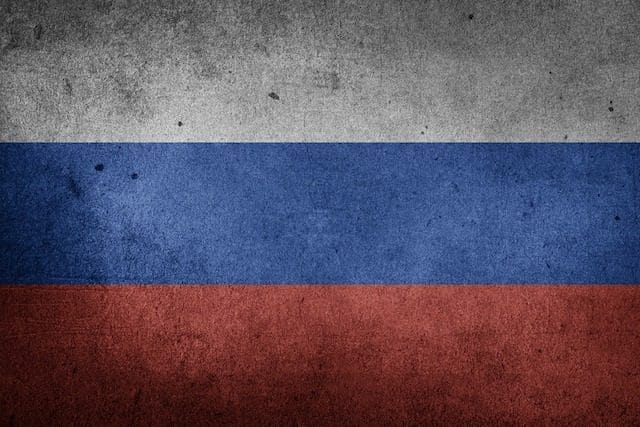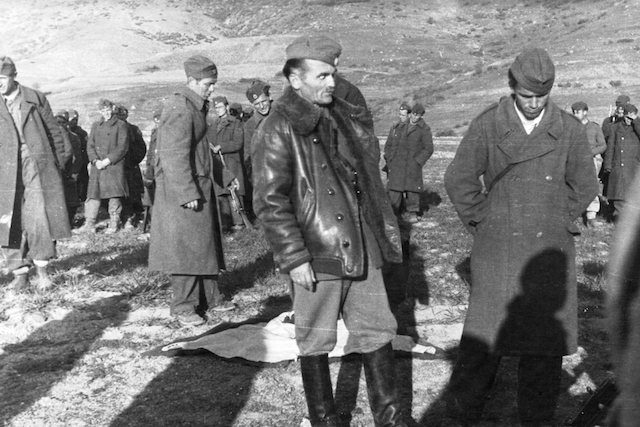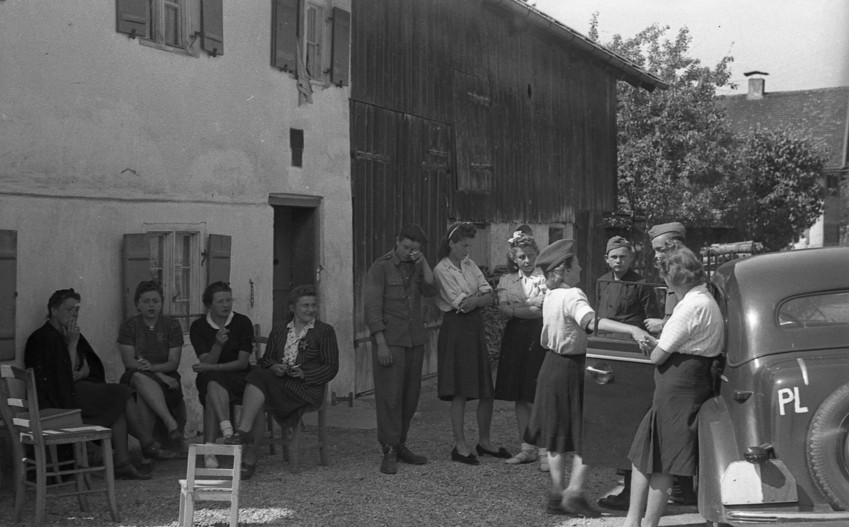When you can’t avoid a war but your enemy is outnumbering you with ridiculous numbers, it’s time to go guerrilla. Multiple military leaders have employed guerrilla tactics to fight seemingly unwinnable battles, and as a result, there have been many ragtag guerrilla forces engaging their enemies in unconventional ways. Let’s take a look at some of the most dangerous ones.
10. The Montoneros of Argentine
The Argentine Montoneros were a left-wing group founded by General Juan Peron, former president and more famously the husband of the legendary Eva “Evita” Peron. Montoneros were out to overthrow the government, and funded their guerrilla operations with bank robberies and high-profile kidnappings of wealthy citizens. Peron left the Montoneros to take care of Peronist business and make life difficult for his opponents before his 1955 exile to Paraguay, and they wreaked havoc throughout his 18 years away from Argentine.
Things took an odd turn for the guerrilla troupe when Peron returned in 1973 and immediately started hanging out with the right wing of the political spectrum, which the Montoneros understandably found unsavory. As a response to this, they organized themselves as a powerful revolutionary left wing and started a massive wave of political violence, assassinations and kidnappings. The violence lasted well after Peron’s death in 1974, but the Montoneros were eventually vanquished by the government in the late 1970s. A good few of the guerrillas mysteriously “disappeared,” but a number of their high-profile members were eventually pardoned and started a new life in more conventional politics.
9. Primorsky Partisans

A fearsome guerrilla group doesn’t always have to be a large or experienced one. In 2010, six young men from the small village of Kirovsky, in the Primorye region in Russia’s Far East, got fed up with what they called constant abuse by the local police, and retaliated by forming a group they called Primorsky Partizany — the Primorsky Partisans. The Partisans embarked on a reign of terror, stalking the area’s police officers and targeting them in a series of violent attacks that killed at least two people. They also released a number of videos, where they explained their anti-police agenda and fully accepted the fact that their guerrilla antics will likely end up badly. “We’re honest people and you’re scum,” they said. “That’s why we’ll wage war against you until the very end, until you kill us or we win. You’ll probably kill us first.”
The Russian authorities were baffled by this open civilian resistance, which was without equal in the country’s contemporary history. However, they soon reacted by sending in several hundred OMON riot officers, helicopters and even tanks. The Partisans engaged them in a months-long game of cat and mouse, but were eventually captured. Two of them died during the arrest (“committed suicide,” as official reports say), but the other four faced trial in Vladivostok. This turned out to be just the beginning of their tale, as many Russians sympathized with the guerrillas and the court found it hard to decide whether the Partisans were cold-blooded murderers or freedom fighters, especially as the authorities also tried to pin unrelated murder cases on them. In 2016, a retrial cleared them of all crimes except for the police attacks, and the court even acquitted two of the living Partisans.
8. Mujahideen

Mujahideen, or “those engaged in jihad,” is a broad term and can technically encompass any Muslim who proclaims to be a warrior for their faith. However, according to Encyclopaedia Britannica it’s most commonly used about the guerrilla groups that opposed the Soviet forces in Afghanistan, and eventually proved instrumental in the winning the Afghan War of 1979-1992 and claiming the country back from the Afghan communist government.
The Mujahideen guerrilla groups of Afghanistan eventually started fighting against each other, but they left a terrifying legacy that is still known today: As the other groups were fighting each other, one particular guerrilla faction rose above the rest and became a force to be reckoned with. You might have heard of them — they’re called the Taliban.
7. The Greek Democratic Army

For most European nations, 1945 was a pretty good year: World War II ended, and rebuilding could begin. Greece, on the other hand, was a different story. The country plunged right into a new war, which was even more vicious than the global one it had fought before. Between the two World Wars, Greece had already been a political battleground, with numerous coup d’etats and literal dozens of governments. Monarchists, republicans and communists all sought to undermine each other and rise to the top, and the end of WWII did nothing to relieve these tensions. By 1946, the country entered a four-year state of civil war.
One of the most fearsome factions in the turmoil was the Greek Democratic Army, which was a renamed version of the WWII-era Greek resistance movement’s guerilla unit, ELAS. Despite its name, the Democratic Army was in complete control of the country’s Communist Party, and with its experience in guerrilla tactics, it was a fearsome adversary to any opposing faction. However, the Democratic Army eventually deemed itself strong enough to drop guerrilla warfare and engage its opponent — the heavily US-backed Greek National Army — in open combat. This left them at a significant disadvantage, and when they tried the ill-advised tactic of “relocating” up to 28,000 Greek children in “safe havens” (or, as official papers imply, Communist training centers to turn them into a massive army), the public opinion turned against them as well.
6. The Angry Brigade
The awesomely named Angry Brigade were British 1970s icons of the radical left, but instead of playing revolutionary songs like their name might imply, they went full guerrilla and arranged a series of bomb attacks against the establishment. Between 1970 and 1971, they managed to get away with an impressive 25 attacks on British soil, which fortunately killed no one but were a serious problem for the government, for obvious reasons.
The “Angries” were the reason Britain founded the Bomb Squad in January 1971, and for a while, their sole purpose was to catch the faction. This took the Squad until August, when they tracked the Angry Brigade down to a quiet house on Amhurst Road, London. A highly successful raid led to the arrest of four Brigade members and the confiscation of various guns, ammunition, bomb-making tools and a number of documents that listed some extremely high-profile targets, some of whom the Brigade had already attacked. Some officers hid out in the house, and arrested several other Angries (including one known anarchist and one former student activist) when they came by the next day.
5. Goryani

When a guerrilla force is called “People of the Forest,” you know they’re pretty good at what they do. That’s the literal translation of Goryani, a resistance force comprised of Bulgarians who didn’t much care for the Soviet Red Army rolling in the country in 1944, and took to the woods for some good, old-fashioned guerrilla warfare. The Goryani were active from 1944 to 1955, and at the height of their power they had roughly 2,000 active members. However, at least 8,000 people supplied the guerrilla fighting force with rations, clothes, weapons and information, so in practice the anti-communist resistance was an estimated 10,000 people strong.
Predictably, the Soviets didn’t much care for the Goryani, and after years and years of massive effort managed to put down the movement by capturing and executing its leaders, as well as torturing and imprisoning many lower level members. In 1955, some of the last remaining active Goryani members retreated to Greece, where they launched the Goryanin Radio Station and blasted anti-communist propaganda at their home country until 1961.
4. The Communist Resistance in Austria

What with one geographical thing and another, Austria was very close to the hub of the Nazi movement, and the country’s National Socialist regime didn’t much care for Communists — especially Communists who were actively opposing them. Still, despite being oppressed, persecuted and brutalized with all the ways Nazis could come up with, Communists organized many resistance groups in Austria.
Their tactic was to throw away their differences with other political groups such as Social Democrats, and focus on the patriotic need to throw Nazis away from the country and reclaim independence. This helped the Communists to become the largest and most effective Austrian guerrilla force that opposed Nazis. They were resilient, too. The Gestapo was highly effective at breaking up their groups and networks, and had arrested as many as 6,300 Communist party supporters by 1943. Still, the resistance groups always made a spirited attempt to reorganize … even though the Gestapo occasionally managed to infiltrate their very ranks.
3. Bagong Hukbong Bayan

Bakong Hukbong Bayan, a.k.a. the Philippines’ New People’s Army, started out as an ideological effort within the country’s Communist party. It was the Marxist-Leninist wing of the party, opposing the pro-Maoist and pro-Soviet offshoots of the ideology. However, in 1969, leaflets and spirited debate soon gave way to the New People’s Army, an armed wing that started partaking in guerrilla activities in the early 1970s.
The New People’s Army mainly operated in rural areas within reach from their four sanctuary bases, but it was far from a harmless pack of bandits; In 1986, the Pentagon estimated that the group had a total of 24,430 fighting members, and a year before that they reportedly killed enemy soldiers at a rate of 100 men per month. Even after the Marcos regime they had been fighting toppled in 1986, the Bakong Hukbong Bayan kept fighting, and by the time things got so bad that President Ronald Reagan had to unleash the CIA to help the Philippine Army, an estimated 60,000 people had died in the conflict.
Not that the conflict ever really ended — the New People’s Army is still out there, and in 2017 President Rodrigo Duterte declared them a terrorist organization.
2. God’s Army of Burma
God’s Army is one of the strangest guerrilla groups in history, if only because of their leaders: Johnny and Luther Htoo, a pair of cigarette-smoking, hardcore 12-year-old twins who led the rebel faction against Burma’s military junta. The two soon became legends in the region, and people whispered that the God’s Army couldn’t be harmed with bullets, and that the very approach of its twin leaders caused landmines to safely rise from the ground. The hundreds of guerrillas under the Htoos’ command practically worshipped the twins, and they answered the call by being fearless in the face of death, yet maintaining a strict discipline within their rank: Everyone was required to practice a rigorous Christian routine, and no alcohol was allowed.
The Htoos started carving their legend in 1997, when the junta’s troops started pushing in the territory of the Karen ethnic group, which was rebelling against the government. The twins decided to fight the oppressor when the Burmese Army entered their village, armed with nothing but a prayer and seven rifles they had secured from the Karen National Union. They won, and before long, the God’s Army started to rain righteous doom against the powers that be.
Unfortunately, their fortunes changed in 1999, when they aligned themselves with a more extremist fringe faction that attacked Myanmar’s embassy in Thailand and later, a Thai hospital. By 2000, the God’s Army had to fold in the face of pressure from both Myanmar and Thailand, and the Htoos surrendered and were sent to a refugee camp. Both boys survived their bloody adventure, though they were eventually separated. Johnny went on to live in Thailand, while Luther started a new life in Sweden, of all places.
1. Revolutionary Armed Forces of Colombia
The Revolutionary Armed Forces of Colombia, who you might know better by the commonly used Spanish abbreviation FARC, are the guerrilla group that just won’t quit. They have been fighting their insurgency since 1964, when they were founded as an armed wing for the country’s Communist Party. At its most powerful in 2002, FARC had an estimated 20,000 fighters, though their numbers have dwindled to somewhere in the ballpark of 6,000-7,000 active warriors, plus a further 8,500 civilians who support them with supplies and intel.
FARC is a very classic, though extremely well-organized guerrilla force: Their structure consists of a huge number of tiny tactical groups, which work under larger blocs that operate in designated regions. The blocs are controlled by the “Secretariat,” which consists of a handful of top brass, and the supreme leader of the whole organization, who goes by the name of Timochenko. The revolutionary force was founded by small-time farmers and other downtrodden Colombians at a time where the country was ravaged by a decade-long civil war and inequality was at its height. However, the waters have become a bit muddied over the years, because in their constant battle against the Colombian establishment and the country’s security forces, FARC have left behind a large number of civilian victims, they’ve dabbled in drug business, and human rights organizations have accused them for forcibly recruiting children. They have also kidnapped thousands of people for ransom, and some of the victims have been held captive for years. One particularly unlucky police officer, Luis Mendieta, was a FARC prisoner for 14 years before the Colombian army managed to rescue him.